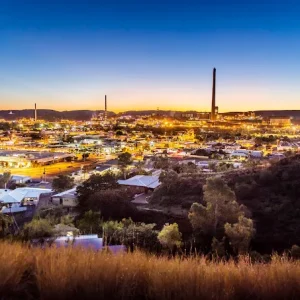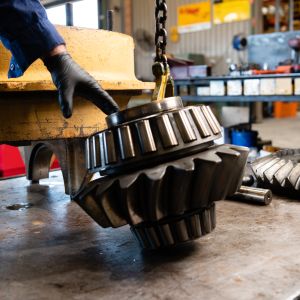We expect businesses to have a so called “social license”, which means to do the right thing by the community it operates within. Probably the toughest field in which to secure a social license must be mining and value-added refining, so thought it appropriate to look at the comments about a lack of “social license” related to a very prominent 100 year old mine, and will let you be the judge as to where the “social license” has fallen apart.
Mount Isa Mines (I’ll use MIM for simplicity as there have been various owners (currently Glencore) and structures including the processing facilities) was founded in 1924, and without the mine, there would not have been a town in the first place. The mine had to guarantee the rail line to the coast in 1929 against any losses to the Government, and in 1960 had to build a power station to feed its operations as well as the growth of the town. In 1958 MIM funded a new dam on the Leichhardt River to supply Mt Isa, creating Lake Moondarra.
Largely due to its remote location, MIM always had to be at the forefront of mining technology and efficiencies in order to be able to compete. Whilst the ownership has changed over the years, the company has always supported the local community. Apart from being the major employer (over 3,200 employees and contractors), they funded other infrastructure such as the first school and church, Mt Isa Hospital and the Royal Flying Doctor Service base. Other current local community support includes the Mount Isa Mines Rotary Rodeo.
For many of the years since its inception, MIM has had to endure big losses and big profits. The Mt Isa copper processing operation is one of only 2 in the country and the only facility available to other mines to value add to the product. The closest measure of the importance of MIM to the local community is that they pay $372 million in wages and $631 million spent with local businesses and community organisations each year and contribute $1.8 billion to Gross Regional Product. I can’t find reliable information on the amount of taxes and profits over the years, but it is very clear that the company has contributed billions upon billions to both State and Federal Governments also. The copper smelter and associated refinery in Townsville is losing an estimated $30 million per month.
I am against Government bailouts of businesses for many reasons. These include that it goes to those “too big to fail” whilst the same is never available to “mums and dads” who lose their house under similar circumstances as much as that it creates companies and industries that never regain its competitiveness, preferring to suck on the taxpayer teat. Witness for example our automotive industry; interventions in the airline industry (REX currently); the Whyalla Steel works and several other refineries; and not least every single renewable energy project (not 1 has ever been viable without Government subsidies nor regulatory support). The worst part is when the taxpayer support is handed to foreign owned companies, but in reality they have options to put their investment funds where they see the best returns, which clearly isn’t Australia when in the end it actually costs them money to close down. Throwing in the towel is therefore a last resort.
So it is quite galling to hear senior politicians (right up to the Prime Minister) make comments that MIM and other companies must “step up and invest” and give back to the community/country that they have supported for such a long time. As I’ve highlighted in the past, the Federal taxes that just BHP pays each year is the same as funding half of Australia’s entire Health budget.
We can’t blame Glencore for asking for taxpayer handouts (that’s what they are, they are not Government handouts, just dished out by them, an important difference) when it seems more and more businesses get them. The $600 million split 50/50 between the Federal and State Government over 3 years with minimal strings attached will basically just cover the current monthly losses of the refinery (not any mining losses) over that period. That’s actually not enough, with the company forecasting $2.2 billion in losses over the next 7 years, and “hoping that conditions improve over the next 3 years to the point where Government assistance is no longer required”. Based on that the reasons for the company now being unviable comes back to a few factors, “hoping” won’t be enough. The two biggest factors are that power prices are amongst the highest in the world and the Industrial Relations framework the most onerous in the world – both which are becoming worse for businesses each year.
Everybody else who pays net tax (which is most PAYG employees and small and medium businesses) should expect better than this. What is the point of collecting more and more taxes just to hand over to those who can’t make it work? Isn’t a much better solution to look at WHY MIM and all these companies that can’t make money don’t stack up, and then remove those hurdles? That means stopping all subsidies and letting the market find ways to make it work – but the trade off must be the good old free market economics which means much less onerous regulation, and policies (not handouts) that encourage exploration, development and investment.
There is a common thread in why many of these companies don’t stack up any more. In a country with abundant natural resources especially for power generation, we should have the cheapest and most reliable power system in the world. When not 1 refinery is viable any more due to exponential cost increases in power prices as more renewables enter the grid, clearly we have a problem and should stop everything causing the current trajectory. Remember the definition of insanity is to keep doing the same thing over and over, hoping for a better result. So go back to what worked and stop handing money to technologies that don’t stack up.
We have recently heard from the highest politicians in the land (and State) that the mine needs to give back to the community. So when is enough, enough? Using MIM as an example, they have basically kept a city of now 22,000 people alive for nearly 100 years – when do these people expect them to not be responsible for that any longer? It has been known for many years now that the mine will one day have to close down, and the question needs to be asked as to what Government has done to ensure there is a future not only for the mine, but also the whole community. What efforts have they put in to help the city move from being basically a 1 company town? And there are things Government should do (aside from setting a competitive landscape for business investment) that cost nothing. For instance, now with “working from home” being prevalent in Government especially, why haven’t Federal and State Governments been ensuring all new and replacement roles be placed in Mt Isa and other regional communities?
So the next time you hear about “social licenses” not being met, please reflect on just what that means and perhaps it’s not the private sector that are the ones failing in their end of the bargain. Perhaps we should see MIM and Mt Isa as a metaphor and bellwether to what is happening with the private sector and Australia.
Words from the wise
“Opportunity is missed by most people because it is dressed in overalls and looks like work.” – Thomas Edison.
“I have never understood why it is greed to want to keep the money you have earned but not greed to want to take someone else’s money” – Thomas Sowell
As always, Onwards and Upwards!
Fred Carlsson
General Manager




